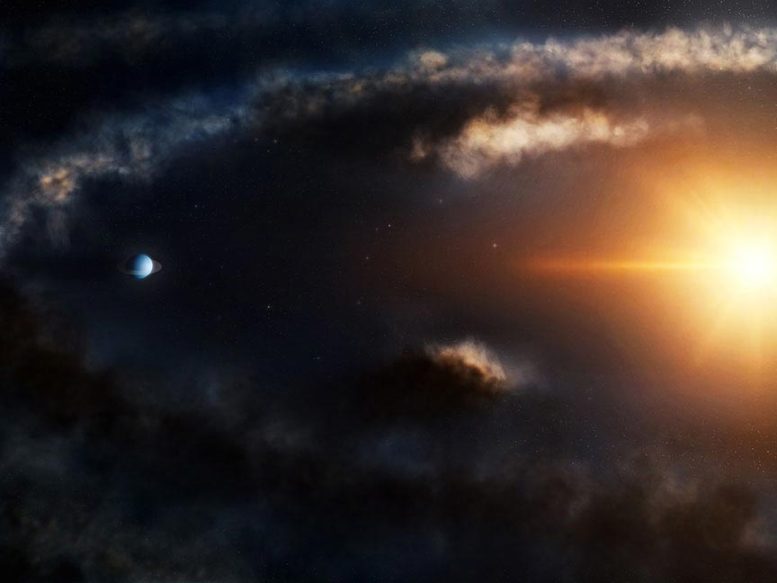
A new technique has been developed by astronomers to identify small planets hidden in protoplanetary disks.
According to astronomers and astrophysicists, planets are born in protoplanetary disks — rings of dust and gas that surround young, newborn stars. Although hundreds of these disks have been detected throughout the universe, observations of actual planetary birth and formation have proved difficult within these environments.
Astronomers at the Center for Astrophysics | Harvard & Smithsonian (CfA) have now developed a new way to detect these elusive newborn planets. With it, they have uncovered “smoking gun” evidence of a small Neptune or Saturn-like planet lurking in a disk. The results were described on September 14 in The Astrophysical Journal Letters.
“Directly detecting young planets is very challenging and has so far only been successful in one or two cases,” says Feng Long, a postdoctoral fellow at the Center for Astrophysics who led the new study. “The planets are always too faint for us to see because they’re embedded in thick layers of gas and dust.”
Instead, scientists must hunt for clues to infer a planet is developing beneath the dust.
“In the past few years, we’ve seen many structures pop up on disks that we think are caused by a planet’s presence, but it could be caused by something else, too,” Long says. “We need new techniques to look at and support that a planet is there.”
Discoveries in the LkCa 15 Disk
Long decided to re-examine a protoplanetary disk known as LkCa 15 for her study. Located about 518 light years away, the disk sits in the Taurus constellation on the sky. Previously, researchers reported evidence for planet formation in the disk using observations with the ALMA Observatory.
After diving into new high-resolution ALMA data on LkCa 15, obtained primarily in 2019, Long discovered two faint features that had not previously been detected.
About 42 astronomical units out from the star — or 42 times the distance Earth is from the Sun — Long discovered a dusty ring with two separate and bright bunches of material orbiting within it. The material took the shape of a small clump and a larger arc, which were separated by 120 degrees.
To figure out what was causing the buildup of material, Long examined the scenario with computer models. She discovered that their size and locations matched the model for the presence of a planet.
A Closer Look at Lagrange Points and Planet Formation
“This arc and clump are separated by about 120 degrees,” Long says. “That degree of separation doesn’t just happen — it’s important mathematically.”
Long points to positions in space known as Lagrange points, where two bodies in motion — such as a star and orbiting planet — produce enhanced regions of attraction around them where matter may accumulate.
“We’re seeing that this material is not just floating around freely, it’s stable and has a preference where it wants to be located based on physics and the objects involved,” Long explains.
In this case, the arc and clump of material Long detected are located at the L4 and L5 Lagrange points. Hidden 60 degrees between them is a small planet causing the accumulation of dust at points L4 and L5.
According to the results, the planet is roughly the size of Neptune or Saturn, and around one to three million years old. (That’s relatively young when it comes to planets.)
Due to technology constraints, directly imaging the small, newborn planet may not be possible any time soon. However, Long believes further ALMA observations of LkCa 15 can provide additional evidence supporting her planetary discovery.
She also hopes her new approach for detecting planets — with material preferentially accumulating at Lagrange points — will be utilized in the future by astronomers.
“I do hope this method can be widely adopted in the future,” she says. “The only caveat is that this requires very deep data as the signal is weak.”
Long recently completed her postdoctoral fellowship at the Center for Astrophysics and will join the University of Arizona as a NASA Hubble Fellow this September.
Reference: “ALMA Detection of Dust Trapping around Lagrangian Points in the LkCa 15 Disk” by Feng Long, Sean M. Andrews, Shangjia Zhang, Chunhua Qi, Myriam Benisty, Stefano Facchini, Andrea Isella, David J. Wilner, Jaehan Bae, Jane Huang, Ryan A. Loomis, Karin I. Öberg and Zhaohuan Zhu, 14 September 2022, The Astrophysical Journal Letters.
DOI: 10.3847/2041-8213/ac8b10
Co-authors on the study are Sean Andrews, Chunhua Qi, David Wilner and Karin Oberg of the CfA; Shangjia Zhang and Zhaohuan Zhu of the University of Nevada; Myriam Benisty of the University of Grenoble; Stefano Facchini of the University of Milan; Andrea Isella of Rice University; Jaehan Bae of the University of Florida; Jane Huang of the University of Michigan and Ryan Loomis of the National Radio Astronomy Observatory.
This study involved high-resolution ALMA observations taken with Band 6 (1.3mm) and Band 7 (0.88mm) receivers.
Never miss a breakthrough: Join the SciTechDaily newsletter.